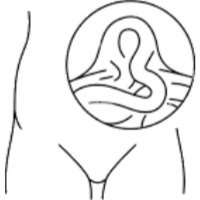

Gastrointestinal (GI) disorders can affect various parts of the digestive tract, from the mouth to the anus. Remember, if you experience persistent GI symptoms, it’s essential to consult us for proper evaluation and management.

Open/ Laparoscopic Cholecystectomy is the surgical removal of the gallbladder. It can be done through an open incision or laparoscopically (minimally invasive). This procedure is commonly performed to treat gallstones or gallbladder-related issues.

Open/Laparoscopic Inguinal hernia repair involves fixing a hernia (a bulge or protrusion) in the groin area. It can be done through open surgery or laparoscopy. The surgeon reinforces the weakened abdominal wall to prevent the hernia from recurring.

Open/Laparoscopic Appendicectomy is the removal of the appendix. It is typically performed in cases of acute appendicitis. Laparoscopic appendicectomy involves small incisions and specialized instruments.

Epigastric hernia repair, addresses hernias that occur in the upper abdomen, specifically above the navel. The surgeon repairs the weakened abdominal wall to prevent tissue or organs from protruding.

A Hydrocele is a fluid-filled sac around the testicle. The operation involves draining the fluid and repairing the sac. It is common in adults and usually not serious.

Pilonidal Sinus, is an abnormal tract or channel that forms in the skin near the tailbone (coccyx). Treatment involves drainage, excision, and wound care.

Haemorrhoids (piles) are swollen blood vessels in the rectum or anus. Treatment options include lifestyle changes, medications, and surgical procedures.

Stapled haemorrhoidectomy is a minimally invasive procedure to remove haemorrhoids. It uses a circular stapler to reposition and remove excess tissue.

Intra-abdominal abscesses are localized collections of pus within the abdominal cavity. Treatment involves drainage and antibiotics.

Pelvic abscesses occur in the pelvic region. Treatment includes drainage, antibiotics, and addressing the underlying cause.

Subphrenic abscesses form beneath the diaphragm. Treatment involves drainage and managing any associated conditions.

Laparotomy for Duodenal, Ileal, Colonic Perforation Repair with Ileostomy and Colostomy Laparotomy is an open abdominal surgery. Repairing perforations (holes) in the duodenum, ileum, or colon may require creating ileostomy or colostomy openings.

Open rectopexy is a surgical procedure to treat rectal prolapse. The rectum is secured to the sacrum to prevent it from protruding.

Bariatric surgery aims to promote weight loss by altering the digestive system. Procedures include gastric bypass, sleeve gastrectomy, and adjustable gastric banding.

Nissen's fundoplication is used to treat gastroesophageal reflux disease (GERD) and hiatus hernia. It involves wrapping the top of the stomach around the lower esophagus to prevent acid reflux.

Removal of cysts in the epididymis (near the testicles) or sebaceous cysts (skin cysts filled with keratin). These procedures are typically straightforward and done for comfort or cosmetic reasons.

IBS is a functional GI disorder where the GI tract appears normal but doesn’t function properly. Symptoms include abdominal pain, bloating, and changes in bowel habits.

GERD causes acid reflux due to a weakened lower esophageal sphincter. Symptoms include heartburn, regurgitation, and chest discomfort.

A functional problem that makes it difficult to have regular bowel movements. It can result from inadequate fiber intake, changes in routine, or other factors..

An overgrowth of bacteria in the small intestine, leading to symptoms like bloating, diarrhea, and malabsorption.

These are solid particles that form in the gallbladder and can cause pain, especially after eating fatty foods1.

An autoimmune disorder triggered by gluten consumption, damaging the small intestine lining and causing symptoms like diarrhea, fatigue, and weight loss.

A type of inflammatory bowel disease (IBD) that can affect any part of the GI tract. It leads to inflammation, pain, and diarrhea1.

Another form of IBD, UC specifically affects the colon and rectum, causing inflammation, bleeding, and frequent bowel movements.